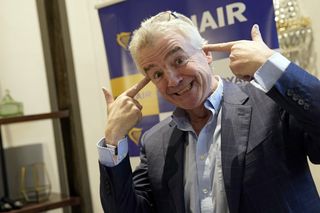'The Walk': Manhattan's high-wire miracle
Head for heights: Even watching the Joseph Gordon-Levitt movie is a balancing act.
I don't know if you suffer from vertigo at all but I sure as hell do, and some of the scenes in Robert Zemeckis' new film were almost too much for me. The Walk tells the story of Philippe Petit, a French street performer and tightrope artiste who in the late summer of 1974 pulled off one of the most extraordinary aerial feats ever attempted by man.
On the morning of August 7, Petit stepped off the side of the South Tower of Manhattan's newly constructed World Trade Centre on to a quarter-inch-thick cable suspended a quarter of a mile above the ground, and proceeded to walk calmly back and forth between the two skyscrapers, to the joy and amazement of a gathering crowd below. When I visited the Twin Towers in the 1990s, I was amazed by the gallery of photographs showing Petit standing, kneeling, sitting and even lying on wire, and remember wondering where on earth he'd found the nerve to do it. In The Walk we're given a few clues.
Joseph Gordon-Levitt plays Petit, a young busker and magician who becomes obsessed by the Twin Towers after seeing photos of them under construction in a magazine. He enlists a team of accomplices that include his girlfriend, Annie Allix, and slowly plots a kind of artistic heist he believes will earn him immortality. His story has been told before in James Marsh's brilliant 2008 documentary Man on Wire, but Robert Zemeckis's film dramatises it, and does such a brilliant job of recreating the Twin Towers walk itself in 3D that at times I could hardly bear to watch.
The film gives audiences a sense of what an extraordinary logistical and artistic triumph Petit's walk was, his achievement made all the more special of course by the fact that it can never now be replicated. He planned it like a crime, and though his walk was interrupted by the arrival of the NYPD, who promptly arrested him once he'd finally agreed to get down off the rope, Petit was treated with indulgence by the courts, who must have reckoned he deserved it. And afterwards he would stay on in New York, and become a kind of adopted local hero.
Born in Nemours, France on August 13, 1949, Petit as a child developed a fascination with magic, the circus and most particularly trapese-artistry. An accomplished unicyclist and street magician (he was one of the first street performers to appear in 60s Paris), Petit's great love was walking the tightrope, and the sense of freedom and weightlessness it entailed.
But working on circus wires a mere 20 or 30 feet above the ground didn't seem like much of a challenge to Petit, who considered himself a performance artist and wanted to turn his high-wire walks into events.
He announced himself to the world by appearing in the air above Paris in the late 1960s, completing a daring walk between the towers of Notre Dame with the help of his close friend Jean-Louis Blondeau, much to the delight of the cathedral's priests, who must have loved the heavenly symbolism. Blondeau then helped him plan and execute a tightrope stunt in the rafters of the Sydney Harbour Bridge, but these stunts were merely the prelude to the walk that would become Petit's masterpiece.
In 1968, Philippe Petit was sitting in a dentist's waiting room skimming through magazines and nursing a broken tooth when he when he came across an article on the then-unfinished World Trade Centre in an old magazine. Standing almost 1,400 feet high, the twin towers would become the tallest buildings in the world at that point, and Petit decided there and then that he would walk between them. He became obsessed with them, collecting articles and information and travelling back and forth to New York as he gradually formulated a plan. It would take him six years to organise and execute his daring Twin Towers walk, with the help of a small team including Annie Allix and Jean-Louis Blondeau.
As the towers rose, Philippe Petit schemed. He visited the site numerous times, posing as a journalist, an architect and a tourist, and using a variety of wigs, costumes and fake moustaches to avoid arousing any suspicion. He even flew over the buildings in a helicopter with a photographer, and used the resulting images to create a scale model so he could work out in detail the logistics of the walk.
He learnt everything he could about the towers, including their built-in sway and the problems wind might pose at such extreme heights. A considerable amount of heavy equipment would be needed for the walk, including a 450-pound steel cable. Petit's planning was meticulous, and it had to be, because a careless calculation might have cost him his life.
On the evening of August 6, 1974, Petit and his team set to work. Using forged identification cards, they gained entry to the World Trade Centre posing as construction workers hired to install an electrified fence on the roof. Having sneaked on to a service elevator that took them to the 104th floor of the South Tower, they concealed themselves around the unfinished office space to await the dawn.
It would be a fraught night, as Petit and an accomplice hid under tarpaulins and narrowly escaped discovery by wandering night watchmen. Towards dawn they stole on to the roof and looked in hope towards the North Tower, where Jean-Louis Blondeau and a second team were supposed to be waiting.
They eventually appeared, and Blondeau used a bow and arrow to fire a line between the buildings. It landed, just about, and the French team then passed thicker and thicker ropes across the abyss until eventually they were able to pull across the heavy cable. The cable was steadied with cavalettis, or guy lines, which were securely fastened and would hopefully stop it flipping excessively in the wind once Petit had begun his sky walk.
In To Reach the Clouds, a book he subsequently released about his experiences, Perit described the bizarre moment when the wire was up, he had donned his black performance costume and was about to begin walking when a man appeared on the South Tower's roof to admire the dawn. He was dressed in a sharp suit, and his face betrayed no emotion when he turned to find Petit and a young accomplice standing near the tower's edge, where the wire could clearly be seen.
It must have been obvious what was going on, but the man merely smiled, nodded his head and disappeared down the stairs. He raised no warning, but Petit never found out who the mysterious stranger was.
At 7.15am on August 7, 1974, Philippe Petit stepped off the South Tower and into history. As a crowd slowly gathered far below to watch a man with a long pole apparently floating in the air, Petit walked, knelt and danced his way across the wire, completing eight crossings in all. At one point he lay on his back and, as he described it, "communed" with a no-doubt bemused seagull that hovered curiously overhead.
By now word of his exploits had started to spread: panting policemen arrived on the roofs of both towers, and an NYPD helicopter thundered into view above Petit's head, from which an officer began shouting at him angrily through a megaphone. This was surely not the wisest move, as any distraction could have been fatal for Petit, who was visibly tiring and chancing his luck by teasing the cops and turning on his heels on the quivering wire.
One of the policemen waiting on the North Tower later recalled the scene: "I observed the tightrope 'dancer' - because you couldn't call him a 'walker' - approximately halfway between the two towers. And upon seeing us he started to smile and laugh and started going into a dancing routine on the high wire… He was bouncing up and down - his feet were actually leaving the wire… Everybody was spellbound by the watching of it".
And who could blame them. It was a magical, extra-human moment, enthralling in its sheer unlikeness. As soon as he stepped back on to terra firma, Petit was arrested and arraigned before a judge, who saw the funny side of things and sentenced Philippe to entertain children with his tightrope-walking in Central Park.
After being released from custody, Petit became a New York hero, was feted in the city's press and given a lifetime pass to the World Trade Centre's observation deck. That pass is still valid, a ticket to a vacant space in lower Manhattan's mid-air.
Documentary time in Kells
The Guth Gafa International Documentary Film Festival is currently in full swing in Kells, Co Meath. Over three days, on five screens, the independent festival is screening 30 top Irish and international documentary features, some of which have already been honoured at the Sundance, Tribeca and Hot Docs festivals. Many of the screenings take place in the stunning surrounds of Headfort House, a Georgian mansion on the outskirts of Kells, and almost half this year's films have been made by women.
Highlights include After the Dance, a moving film by Daisy Asquith, who returns to Ireland to explore the story of her mother's conception after a 1940s dance on the west coast of Ireland; Dreamcatcher, Kim Longinotto's profile of Chicagoan activist Brenda Myers-Powell, a former prostitute who now helps women break the cycle of sexual abuse and exploitation; and Democrats, Camilla Nielsson's exploration of Zimbabwe's struggle to move beyond the smothering autocracy of the Mugabe era.
In addition there'll be master-classes, discussions and a children's programme. For more information, and tickets, visit guthgafa.com
Join the Irish Independent WhatsApp channel
Stay up to date with all the latest news














